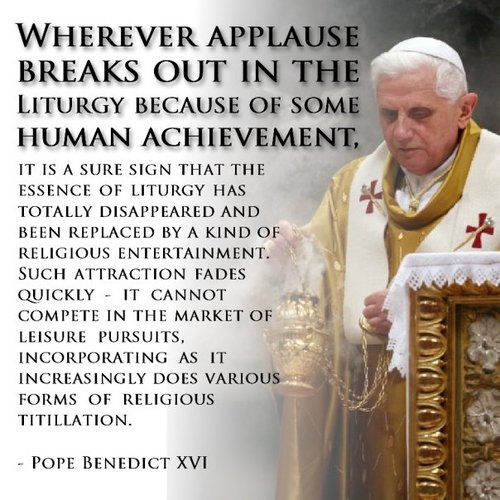Hat tip to Fr Guy Selvester at Shouts in the Piazza for posting this image. Indeed, the sacred Liturgy is worship of the Blessed Trinity not a time for introducing secular measures of approval and disapproval. I was at a priest friend's funeral today and after the homily was finished a member of the laity started the congregation in an applause. Not only was it out of place it bore no relation to the reality of the meaning of the Sacrifice of the Mass being celebrated by the Archbishop of Hartford (himself seemingly surprised yet he drew more attention to the fact that it happened). Not that my friend Father Brian didn't deserved some thoughtful acknowledgement for his extraordinary human and priestly qualities but at his Mass of Christian Burial applause was out of place. Paying attention to human sentiment and emotion is very important but there are appropriate times for external awareness. Something similar happened after a music piece was perforned earlier this week at a Mass which I attended for a friend's nephew who took his life. No doubt we were all feeling the rawness of emotion of a young man's suicide but is the Liturgy the place for secular displays of feeling. My friend Father Ambrose has fought for keeping applause out of the school Mass at St Louis Abbey's conventual Mass celebrated with the student body in attendance...
No applause at the sacred Liturgy
Categories:
Tags:
1 Comments
Leave a comment
About the author

Categories
- Adoration of the Blessed Sacrament (12)
- Advent & Christmastide (96)
- Anglican Ordinariate (21)
- Archdiocese of Hartford (21)
- Archdiocese of New York (86)
- Art & Christianity (20)
- Avery Cardinal Dulles, SJ (11)
- Benedictine Oblate (23)
- Benedictine saints & blesseds (94)
- Benedictines (218)
- Blessed Virgin Mary (153)
- Books (47)
- Canon Law (Church Law) (11)
- Carmelite saints & blesseds (22)
- Carmelites (5)
- Catholic Higher Education (11)
- Catholic Laity (5)
- Catholic Social Concerns (13)
- Catholic priesthood (37)
- Christology (13)
- Church (ecclesiology) (82)
- Church Fathers & Mothers (8)
- Communion & Liberation (155)
- Connecticut Dioceses (21)
- Crossroads Cultural Center NYC (18)
- Culture (248)
- Dominican saints & blesseds (84)
- Dominicans (42)
- Easter, Ascension & Pentecost (78)
- Eastern Church (129)
- Ecumenism (81)
- Encyclicals (6)
- Eucharist (22)
- Evangelization & Formation (71)
- Faith & Ecology (8)
- Faith & Reason (143)
- Faith & the Public Order (86)
- Franciscan saints & blesseds (113)
- Franciscans (64)
- Holy See (129)
- Ignatian Spirituality (19)
- Interfaith Dialogue (38)
- Jesuit saints & blesseds (46)
- John Henry Newman (24)
- Knights of Columbus (33)
- Lectio Divina (15)
- Lent & Holy Week (114)
- Life in a Monastery (24)
- Luigi Giussani (36)
- Oratorian saints and blesseds (9)
- PAZ (13)
- PAZ & Friends (64)
- Pope Benedict XVI (270)
- Pope Francis (76)
- Pope John Paul I (4)
- Pope John Paul II (38)
- Pope Paul VI (11)
- Pope Pius XII (8)
- Pro Life (76)
- Religious Freedom (22)
- Sacred Heart of Jesus (22)
- Sacred Liturgy & Sacraments (217)
- Sacred Scripture (54)
- Saint Benedict (14)
- Saint Paul (26)
- Sainthood causes (74)
- Saints (495)
- Spiritual Life (185)
- Sports (10)
- Teaching & Living the Faith (47)
- Theology (95)
- Vatican II (12)
- Vocations (117)
- World Youth Alliance (4)
- Year of Faith (17)
- Year of Saint Anselm (11)
- Year of Saint John Mary Vianney (13)
- Year of Saint John Neumann (7)
- Year of the Priest (19)
stblogs.org
Search
About this Entry
This page contains a single entry by Paul Zalonski published on July 23, 2010 3:21 PM.
Saint Bridget of Sweden was the previous entry in this blog.
Saint Sharbel Makhlouf is the next entry in this blog.
Find recent content on the main index or look in the archives to find all content.


"The context of the present Pope's remarks was regarding applause after so-called liturgical dancing; it did not directly address our present case of applause as a sign of respect and agreement to the message of the homily. The principle involved, however, of not applauding the merely human achievement of one of the liturgical actors could be a good rule of thumb for deciding when applause is appropriate or not."
EWTN website